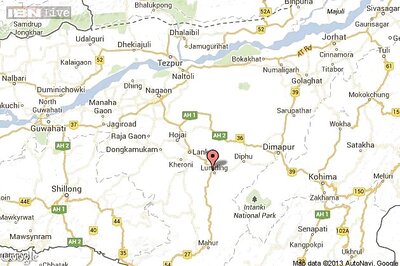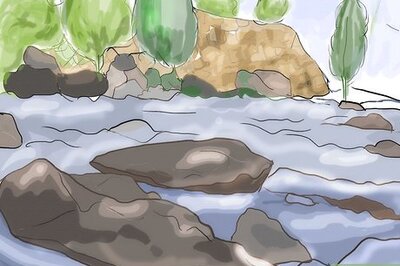
views
What does “dirt neck” mean in slang?
In slang, “dirt neck” is almost always used as a derogatory insult. It’s often used as a general put-down. It might indicate that someone has a low social standing or that they’re unclean. It can also mean someone who spends a lot of time outside or in dirt jobs, like construction workers or other blue collar workers. And sometimes it just means people who participate in outdoor sports and activities that cause them to get—literally—a dirt neck. Rarely, “dirt neck” has been used as a racial slur against African-Americans.
What is Acanthosis Nigricans?
Acanthosis nigricans is a condition that causes skin to look dark and velvety. The skin becomes thickened in areas where it creases, causing it to look darker. Acanthosis nigricans most commonly affects the neck, armpits, and groin, although the skin around the fingers, elbows, and knees may also be affected. Acanthosis nigricans itself is not harmful. However, it is sometimes a sign of an underlying condition, so talk to your doctor about it—especially if it appears suddenly. The skin affected by acanthosis nigricans often feels soft. It may be itchy and more prone to developing skin tags. Acanthosis nigricans is not caused by dirty skin. This condition can not be washed away, and scrubbing won’t lighten the skin. Acanthosis nigricans is not contagious—it can’t be passed to someone else.
Causes of Acanthosis Nigricans
The exact cause of acanthosis nigricans is still being studied. Genetics certainly play a role, as people with a family history of acanthosis nigricans are more likely to develop the condition. Having a darker skin tone may also increase the likelihood of developing acanthosis nigricans. Additionally, some conditions and medications may be risk factors: Insulin resistance: Conditions like diabetes, prediabetes, polycystic ovarian syndrome (PCOS), and Cushing’s syndrome can make the body resistant to insulin. This might increase the chances of developing acanthosis nigricans. Drugs and supplements: If you take birth control pills, corticosteroids like prednisone, or high doses of niacin, you may be more likely to develop acanthosis nigricans. Cancer: Rarely, acanthosis nigricans can develop in patients who have certain cancers, like lymphoma and stomach or liver cancer. Obesity: People who are significantly overweight are at a higher risk of developing acanthosis nigricans.
Acanthosis nigricans is not hyperpigmentation or dirt. It’s not caused by unclean skin, and the darkness can’t be washed away, no matter how much the person scrubs. Additionally, it’s not caused by an increase in skin pigmentation—the skin looks darker because it’s thicker than the skin around it. That means traditional skin lightening treatments are typically not effective for treating acanthosis nigricans.
How is Acanthosis Nigricans diagnosed?
Your doctor may diagnose acanthosis nigricans after an examination. They’ll likely ask you about your family history of skin discoloration, and they’ll physically examine your skin. Additionally, some doctors might do blood tests to check for or rule out underlying causes like diabetes. Your doctor might also take a skin biopsy if the cause of the skin darkening is inconclusive.
Treatment Options for Acanthosis Nigricans
Acanthosis nigricans can fade over time. It may gradually improve once the underlying cause is properly managed. For instance, in patients with diabetes, the skin on their neck may gradually lighten once their insulin levels are stabilized. Or, in patients who are overweight, it may improve with diet and exercise. Similarly, if you’re taking a medication that causes this condition, it may improve once you stop taking that medicine or switch to another one.
Dermatological treatments may also help improve acanthosis nigricans. These treatments are typically designed to help reduce the thickness of the skin—simply lightening the area may not work, since the condition isn’t caused by hyperpigmentation. Talk to your dermatologist about treatments like: Laser therapy/dermabrasion Retinoids Antibiotics (if the acanthosis nigricans causes itching or an odor) Tretinoin Ammonium lactate Urea Salicylic acid
Other Causes for Darkened Skin on the Neck
Terra firma-forme dermatosis Terra firma forme is a fairly rare condition where dark-colored plaques form on the skin. These plaques look like dirt and often occur on the neck or chest, likely as a result of the accumulation of skin cells due to incomplete exfoliation (keratinization). It commonly appears in children. The dark areas can’t be removed by regular washing, but unlike acanathosis nigricans, this “dirt” can be wiped away with a cotton swab or tissue dipped in rubbing alcohol. The condition is often associated with dermatosis neglecta, where a dark, crusty scale appears on the skin in individuals with poor personal hygiene. However, dermatosis neglecta does wash away with regular soap and water, while terra firma-forme does not.
Hyperpigmentation Hyperpigmentation (excessive pigment in the skin) can sometimes occur in the neck, causing it to look darker than the surrounding areas. This may occur due to skin damage or other trauma to the skin.
How do you remove dirt from your neck?
Wash your neck with soap and water and gently exfoliate if it seems dirty. Sometimes, you can get a buildup of dirt on your neck as a result of not fully washing or exfoliating the area properly when you shower. Hair and body products can also create buildup on your skin. To remove it, use a textured sponge or loofah and your regular body soap to thoroughly clean your neck in small circular motions—but don’t scrub to the point that it’s uncomfortable. If the dirt is still there, try swabbing it off with an alcohol wipe or a cotton ball dipped in rubbing alcohol. If that works, the dirt was likely a result of terra firma forme, or unshed skin cells. Continue washing as normal and wipe the area with alcohol as needed until the condition improves.




















Comments
0 comment